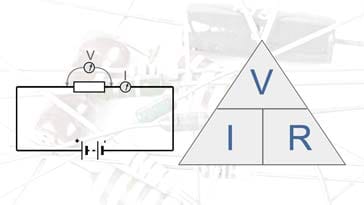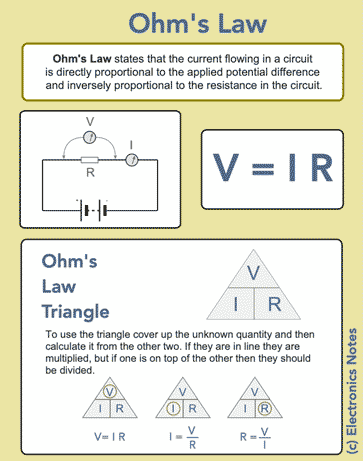Understand Ohm's Law: Calculations, Formula, Triangle, all you need to know
Get to grips with Ohm's Law and its equation with this helpful tutorial which includes the formula, how to use the calculations, Ohm's Law Triangle, Calculator, etc.
Resistance Tutorial Includes:
What is resistance
Ohms Law
Ohmic & Non-Ohmic conductors
Resistance of filament lamp
Resistivity
Resistivity table for common materials
Resistance temperature coefficient
Voltage coefficient of resistance, VCR
Electrical conductivity
Series & parallel resistors
Parallel resistors table
Ohm's Law is one of the most fundamental and important laws governing electrical and electronic circuits.
Ohm's Law relates relates current, voltage and resistance for a linear device, such that if two are know, the third can be calculated.

With current, voltage and resistance being three of the major circuit quantities, this means that Ohm's Law is also immensely important
Ohm's Law is used within all branches of electrical and electronic science, and especially within electronic circuit design. It is used for calculating the value of resistors required in circuits, and it can also be used for determining the current flowing in a circuit where the voltage can be measured easily across a known resistor.
Ohm's Law is used in a vast number of calculations in all forms of electrical and electronic circuit- in fact anywhere that current flows. Here we provide the equations, the Ohm's law triangle as an aide memoire, and an Ohm's Law calculator for when the values are not easy to work out.
Ohm's Law discovery
There is a mathematical relationship which links current, voltage and resistance. A German scientist named Georg Ohm performed many experiments in an effort to show a link between the three. In the days when he was performing his experiments there were no meters as we know them today.
Even though, Georg Ohm knew there was a relationship between potential difference, current and the resistive properties of a material it was really difficult to ascertain what this was - even though it seems very obvious today.
It took considerable effort for Ohm to make his first attempt at discovering the relationship, but this was soon proved wrong - the internal resistance of the batteries he used was probably the cause.
Then, at his second attempt did he manage to devise what we know today as Ohm's Law.
Note on Georg Ohm:
Born in Erlangen, about 50 miles north of Munich in 1879, Georg Ohm went on to become one of the people who investigated much about the new science associated with electricity, discovering the relationship between voltage and current in a conductor - this law is now named Ohm's Law, honouring the work he did.
Read more about Georg Ohm.
What exactly is Ohm's Law?
Ohm's Law describes the way current flows through a material when different levels of voltage are applied. Some materials like electrical wires present little resistance to the current flow and this type of material is called a conductor. Hence if this conductor is placed directly across a battery for example, a lot of current would flow.
In other instances another material may impede the flow of current, but still allow some though. In electrical circuits, these components are often called resistors. Yet other materials let virtually no current though and these materials are called insulators.
In effect, Ohm's Law links three basic electrical parameters, namely voltage or potential difference, current and resistance.
| Three Quantities Related by Ohm's Law |
|||
|---|---|---|---|
| Quantity | Symbol | Units | Unit Symbol |
| Current | I | ampere | A |
| Voltage | E or V | volt | V |
| Resistance | R | ohm | Ω |
Video: Understanding Ohms Law
To gain a first idea of what is happening it is possible to liken the electrical situation to that of water flow in a pipe. The voltage is represented by the water pressure the pipe, the current is represented by the amount of water flowing through the pipe, and finally the resistance is the equivalent of the size of the pipe.
It can be imagined that the wider the pipe, the more water will flow. The reason for this is that it is easier for more water to flow through a wider pipe than a narrower one - the narrower one presents more resistance to the water flow. Also if there is more pressure into e pipe, then for the same pipe, more water will flow.
Ohm determined that for normal materials, doubling the voltage doubled the current flow for a given component. Different materials or the same materials with different shapes will present different levels of resistance to the flow of current.
Ohm's Law definition
Ohm's Law states that the current flowing in a circuit is directly proportional to the applied potential difference and inversely proportional to the resistance in the circuit.
In other words by doubling the voltage across a circuit the current will also double. However if the resistance is doubled the current will fall by half.
In this mathematical relationship the unit of resistance is measured in Ohms.

Ohm's Law formula
The Ohm's Law formula or equation is very straightforward.
Ohm's law can be expressed in a mathematical form:
V = voltage expressed in Volts
I = current expressed in Amps
R = resistance expressed in Ohms
The formula can be manipulated so that if any two quantities are known the third can be calculated.
Ohm's law triangle
To help remember the formula it is possible to use a triangle with one side horizontal and the peak at the top like a pyramid. This is sometimes known as the Ohm's law triangle.
In the top corner of the Ohms law triangle is the letter V, in the left hand corner, the letter I, and in the right hand bottom corner, R.

To use the triangle cover up the unknown quantity and then and then calculate it from the other two. If they are in line they are multiplied, but if one is on top of the other then they should be divided. In other words if current has to be calculated the voltage is divided by the resistance i.e. V/R and so forth.

If the voltage has to be calculated then it is found by multiplying the current by the resistance i.e. I x R.
Ohms Law calculation example
If a voltage of 10 volts is placed across a 500 ohm resistor determine the amount of current that will flow.

Looking at the Ohms Law triangle the current is the unknown leaving the voltage and resistance as the known values.

In this way the current is found by dividing the voltage by the resistance.
If the values are not easy to calculate, then use the calculator at the bottom of the page.
Example 2
In a similar way it is possible to use Ohm's Law to find the resistance if the current and voltage are known. Take, for example, a voltage of 10 volts, and a current 0.1A. Using the Ohm's Law triangle, it can be seen that:
Example 3
Finally, the other combination is that is the resistance and current are known, then it is possible to calculate the voltage expected across the resistance. Take the example of a distance of 250 Ω which has a current of 0.1 A flowing through it, then the voltage can be calculated as below:
Ohm's Law calculator
Although the calculations for Ohm's Law are straightforward, sometimes it is very useful to have a calculator on a website to calculate the actual values, especially of the values are not exact and would need some form of calculator anyway.
Our calculator is very straightforward. Simple add the two values you have and then press return for the third to be calculated. It is also possible to use the up and down arrows in the boxes as well.
The Ohm's Law calculator will determine the values for resistance in Ohms, current in Amps, or Voltage in Volts provided two of the three are known.
Ohmic and non-ohmic conductors
Using Ohm's law it can be seen that if the voltage and current were plotted for a fixed resistor or a length of wire, etc, there would be a straight line.
It can be seen that doubling the voltage doubles the current that passes through the particular circuit element.

On the graph, there are two lines, one for a higher resistance - this one requires more voltage to be applied for a given current flowing. Accordingly this must have a higher resistance. Conversely the curve for the lower resistance shows a component that requires a lower voltage to be applied for a given current.
Components that have a linear or straight line follow Ohms law and they are known as Ohmic conductors. However, not all electrical electronic components have a straight line plot for voltage and current. For a variety of reasons they may have a different voltage / current characteristic. These conductors are often said to be non-Ohmic.
Ohm's Law Summary
It often helps to have a reminder summary sheet for Ohm's law, so I've prepared one that summarises the salient features of Ohm's law
The summary also provides the essential details about the Ohm's law triangle - a very easy way of remembering the various calculations.
With Ohm's law being one of the most basic calculations within electronics and electrical science in general, it is essential knowledge.

Click on image for larger version
Ohm’s Law is one of the most basic concepts within electrical and electronic engineering. The concept of an item having a certain resistance which determines the amount of current that flows through it for a certain voltage is key to the operation virtually all circuits.
 Written by Ian Poole .
Written by Ian Poole .
Experienced electronics engineer and author.
More Basic Electronics Concepts & Tutorials:
Voltage
Current
Power
Resistance
Capacitance
Inductance
Transformers
Decibel, dB
Kirchoff's Laws
Q, quality factor
RF noise
Waveforms
Return to Basic Electronics Concepts menu . . .




